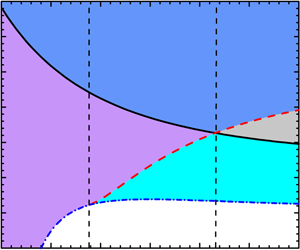Published online by Cambridge University Press: 10 December 2019

The regular reflection to Mach reflection ( $\text{RR}\rightarrow \text{MR}$) transition in inviscid perfect air for shock reflection over convex and straight wedges is investigated. Provided that the variation of shock intensity only has a second-order effect on the wave transition, the possible cases for the occurrence of the
$\text{RR}\rightarrow \text{MR}$) transition in inviscid perfect air for shock reflection over convex and straight wedges is investigated. Provided that the variation of shock intensity only has a second-order effect on the wave transition, the possible cases for the occurrence of the  $\text{RR}\rightarrow \text{MR}$ transition for curved shock reflection over a wedge are discussed. For a planar shock reflecting over a convex wedge, four different flow regions are classified and the mechanism of the disturbance propagation is interpreted. It is found that the flow-induced rarefaction waves exist between disturbances generated from neighbouring positions and isolate them. For a curved shock reflecting over a convex wedge, although the distributions of the flow regions are different from those in planar shock reflection, the analysis for the planar shock case can be extended to curved shock cases as long as the wedge is convex. When a diverging shock reflects off a straight wedge, the flow-induced rarefaction waves are absent. However, the disturbances generated earlier cannot overtake the reflection point before the pseudo-steady criterion is satisfied. In the cases considered, the flow in the vicinity of the reflection point will not be influenced by the unsteady flow caused by the shock intensity and the wedge angle variations. This is clearly a local property of the shock–wall interaction, no matter what the history of the shock trajectory is. For validation, extensive inviscid numerical simulations are performed, and the numerical results show the reliability of the pseudo-steady criterion for predicting the
$\text{RR}\rightarrow \text{MR}$ transition for curved shock reflection over a wedge are discussed. For a planar shock reflecting over a convex wedge, four different flow regions are classified and the mechanism of the disturbance propagation is interpreted. It is found that the flow-induced rarefaction waves exist between disturbances generated from neighbouring positions and isolate them. For a curved shock reflecting over a convex wedge, although the distributions of the flow regions are different from those in planar shock reflection, the analysis for the planar shock case can be extended to curved shock cases as long as the wedge is convex. When a diverging shock reflects off a straight wedge, the flow-induced rarefaction waves are absent. However, the disturbances generated earlier cannot overtake the reflection point before the pseudo-steady criterion is satisfied. In the cases considered, the flow in the vicinity of the reflection point will not be influenced by the unsteady flow caused by the shock intensity and the wedge angle variations. This is clearly a local property of the shock–wall interaction, no matter what the history of the shock trajectory is. For validation, extensive inviscid numerical simulations are performed, and the numerical results show the reliability of the pseudo-steady criterion for predicting the  $\text{RR}\rightarrow \text{MR}$ transition on a convex wedge.
$\text{RR}\rightarrow \text{MR}$ transition on a convex wedge.